“And then, all of a sudden, you feel it, the cold….You perceive it with all five senses, the cold, you see it in the steam that billows out of your mouth, you hear it in the wheeze of your heaving breath, you inhale it like a whipcrack through your nostrils, you even taste it on your parched tongue. And you touch it on her body.”
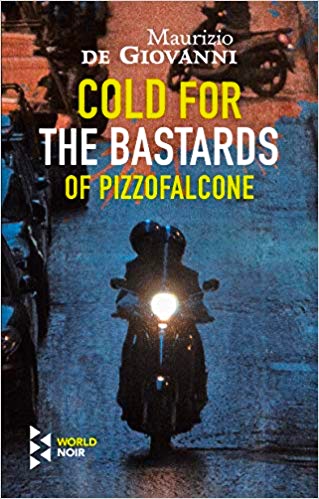 In this fourth novel featuring Inspector Lojacono, a lieutenant in the contemporary Naples police department, author Maurizio de Giovanni succeeds in establishing a second mystery series which is on its way to being as much fun to read as his first, highly successful series starring Baron Ricciardi, a commissario of the Naples Police during the reign of Benito Mussolini. Famous for its well drawn, repeating characters, its insights into everyday life under Mussolini, and its noir subject matter, the Ricciardi series (now numbering nine novels) also highlights de Giovanni’s trademark dark humor. In this installment of the newer Lojacono series, set in the present, de Giovanni’s repeating characters develop far more fully than we have seen in the previous three novels, and their relationships become more intense and insightful. In fact, many readers will find Cold for the Bastards of Pizzofalcone, this newly released fourth novel in the series to be on a par with the best of the Ricciardi series, which has always been more popular.
In this fourth novel featuring Inspector Lojacono, a lieutenant in the contemporary Naples police department, author Maurizio de Giovanni succeeds in establishing a second mystery series which is on its way to being as much fun to read as his first, highly successful series starring Baron Ricciardi, a commissario of the Naples Police during the reign of Benito Mussolini. Famous for its well drawn, repeating characters, its insights into everyday life under Mussolini, and its noir subject matter, the Ricciardi series (now numbering nine novels) also highlights de Giovanni’s trademark dark humor. In this installment of the newer Lojacono series, set in the present, de Giovanni’s repeating characters develop far more fully than we have seen in the previous three novels, and their relationships become more intense and insightful. In fact, many readers will find Cold for the Bastards of Pizzofalcone, this newly released fourth novel in the series to be on a par with the best of the Ricciardi series, which has always been more popular.
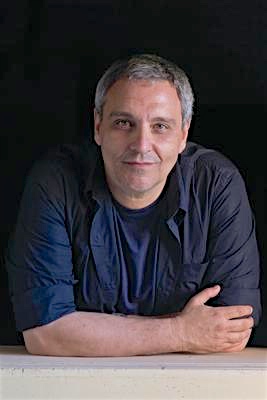 The title sets the tone of the novel, referring to the physical cold of a bleak winter, matched by the cold, alienated mood of current officers at the Pizzofalcone precinct. Major officers here were recently purged from the department for corruption and possible connections to the Neapolitan Mafia after they tried to sell a shipment of narcotics which had been confiscated in a raid. These crooked officers, most of them veterans, were put on trial for obvious crimes or forced to resign. A whole new crew, many of them old-timers who had never achieved recognition by the department, along with a few “outsiders” with personal difficulties and few friends within the department, have been put in charge of the precinct. These new officers must also deal with the insulting sobriquet of “bastards,” which is applied to them regularly by the veteran police throughout the rest of Naples. Worst of all, the Pizzofalcone station is on temporary status and can be closed at any moment by the higher-ups if the officers do not do an effective job – or if they create further problems for the police hierarchy. Working there is like living on the edge.
The title sets the tone of the novel, referring to the physical cold of a bleak winter, matched by the cold, alienated mood of current officers at the Pizzofalcone precinct. Major officers here were recently purged from the department for corruption and possible connections to the Neapolitan Mafia after they tried to sell a shipment of narcotics which had been confiscated in a raid. These crooked officers, most of them veterans, were put on trial for obvious crimes or forced to resign. A whole new crew, many of them old-timers who had never achieved recognition by the department, along with a few “outsiders” with personal difficulties and few friends within the department, have been put in charge of the precinct. These new officers must also deal with the insulting sobriquet of “bastards,” which is applied to them regularly by the veteran police throughout the rest of Naples. Worst of all, the Pizzofalcone station is on temporary status and can be closed at any moment by the higher-ups if the officers do not do an effective job – or if they create further problems for the police hierarchy. Working there is like living on the edge.
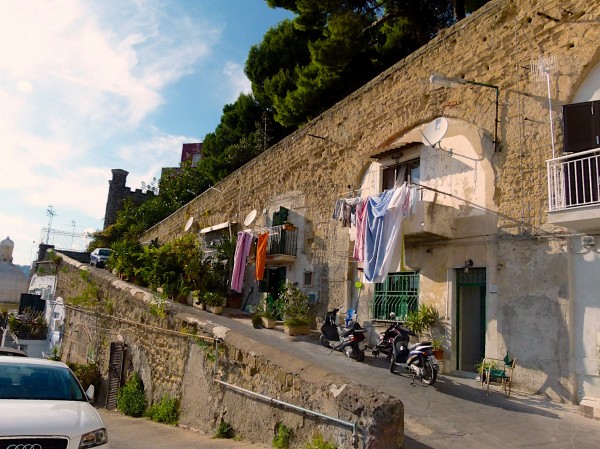
A ramp road goes up the hills of Pizzofalcone, where the roads are sometimes at a forty-five degree angle.
Lieutenant Giuseppe Lojacono is one of the precinct’s outsiders. The most experienced of the “bastards” currently working in Pizzofalcone, Lojacone was sent to Naples from his home in Sicily after a low level member of the Sicilian Mafia turned state’s witness and testified that the innocent Lojacono, who had been particularly effective in rooting out crime there, was, in fact, a Mafia informant. Innocent but unable to prove it, Lojacono was reassigned to Naples, which did not want him. There, for nearly a year, he killed time, until, on his own, he solved the case of the Crocodile (in the first and most violent novel in this series). While he earned a modicum of fame in Pizzofalcone, it was not accompanied by any real respect from the Naples police hierarchy. Working with Lojacone are other characters from previous novels in this series, many of them loners with personal issues who have done their jobs honestly but without “making friends” with people of influence or “making waves” in the department. This odd group of officers develops much more fully here as they gain experience investigating and prosecuting cases, dealing with the higher-ups in Naples, and conducting their business and their own lives, often with complications. As they are thrown together, these characters’ personalities and their accompanying issues come to the fore. Lojacono’s own life is more complicated here because his daughter Marinella, a young teenager from Sicily, has come to live with him. Though he wants to devote all his time to her, she wants to be more independent.
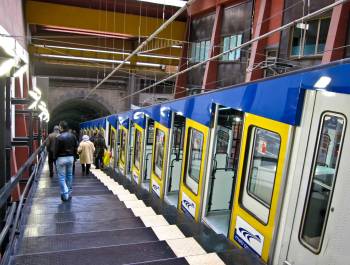
The funicular at Pizzofalcone, used by 28,000 people a day, and over 10 million people a year. The diagonal car is built with stepped platforms for safety.
The big investigation in this novel begins when Lojacono and Alessandra Di Nardo, known as Alex, are called to the site of two murders in the same apartment. A young woman lies sprawled on a bed, her face swollen around the nose and mouth, reddish stripes on her neck. A second victim, a young man, is slumped over a desk, seated, with his head resting on the desk, and his arm, still gripping a pen, dangling beside him. The young male victim, Biaggio Varricchio, a serious researcher at the university, had been expecting a visit from his father, whom he had not seen for seventeen years while his father, convicted of murder, was serving his jail sentence. The second victim is Grazia, Biaggio’s sister, five years younger. Though she had the opportunity to go to college, like Biaggio, she declined, preferring to live with her aunt and uncle, and eventually her brother, close to her boyfriend known as “Nick Guitar” in town, and “Nick Trash” on social media. She has already become well known as a model, with opportunities to be an actress. Her father, outraged by what he imagines her behavior to be, demands that she move in with him so that he can “protect” her, and her refusal to comply enrages him.
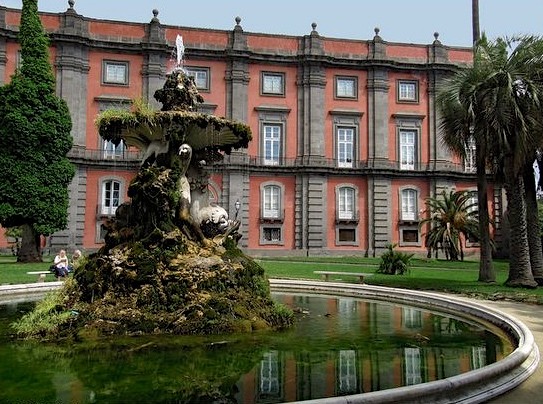
One of the characters enjoys meeting an elderly female friend near the fountain in the park of the Palazzo Reale.
The resulting murder investigation provides the author with an opportunity to examine the lives of all these characters – both the murder victims and the investigators. The primary suspect is of course, the victims’ violent father, who describes his life, thoughts, and fantasies in detail in italicized sections throughout, making it possible for the reader to know him well without having to see him in many action scenes. This allows the author to spend most of his narrative bringing his investigators more fully to life, often with humor. As the complicated lives of the often unconventional “bastards” of Pizzofalcone begin to unfold and the officers become more comfortable with sharing who they are, their love stories also begin to be revealed. Some officers find themselves attracted to others within the precinct, some finally give in and admit their innermost longings, and still others, who have been reticent, finally see how much the love and care of another can change their lives. Ultimately, the novel becomes much more a novel of character and personal interactions than a “murder mystery,” though the search for the killer continues to serve as the unifying factor in the structure of the novel. By the time the murderer is identified, the reader has become so entertained by the growing stories of the characters that it is the insights into them – the “bastards” and their friends – that give life and excitement to the novel. Ultimately, this series, like the Ricciardi series should attract future readers wanting to know the continuing stories of the characters for which the mysteries serve as vehicles. Maurizio de Giovanni is in total control here, and the result is totally satisfying.
ALSO reviewed here: RICCIARDI SERIES, in order: I WILL HAVE VENGEANCE ( #1), BLOOD CURSE ( #2). EVERYONE IN THEIR PLACE (#3), THE DAY OF THE DEAD (#4), BY MY HAND (#5), VIPER (#6), THE BOTTOM OF YOUR HEART (#7), GLASS SOULS: MOTHS FOR COMMISSARIO RICCIARDI (#8), NAMELESS SERENADE (9).
LOJACONO SERIES, in order: THE CROCODILE (#1), THE BASTARDS OF PIZZOFALCONE (#2), DARKNESS FOR THE BASTARDS OF PIZZOFALCONE (#3), PUPPIES (#5)
Photos. The author’s photo appears on https://www.randomhouse.de/
A ramp road goes up the hills of Pizzofalcone, where the roads are sometimes at a forty-five degree angle. https://commons.wikimedia.org
The funiculare at Pizzofalcone, used to transport 28,000 people a day, and over 10 million people a year up the hills, is built with stepped platforms for safety. https://en.wikipedia.org/
One of the characters enjoys meeting an elderly female friend near the fountain in the park of the Palazzo Reale. https://www.pinterest.com/
